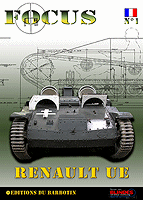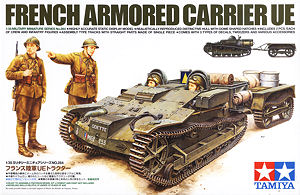Tamiya follow their excellent kit of the French B1 bis (Kit #35282) with this new kit of the small Renault Armored Carrier UE of which 6000 were built for the French Army. After the fall of France many were used by the German Army fitted with different armaments such as the 3.7cm Pak 35/36 and the Wurfkoerper rocket launchers as with the Sd.Kfz.251/1 Stuka Zu Fuss plus numerous other applications which makes this new kit equally appealing to Allied and German modellers.
The kit provides the option to build a Series 2, 3 or 4 vehicle with minor differences in the head lights and tow shackles which requires you to open up some alternate holes in the upper hull for the appropriate version so watch this before construction begins.
You also get two half crew figures for the Commander and Driver inside the hatches and two full French Infantry figures to use in a diorama situation as well as the tracked trailer pulled by the UE and a selection of fuel drums, wooden boxes and packs to load up.
The kit consists of 255 parts in olive drab plastic 8 small poly caps and the decal sheet plus for something completely different a bonus a pair of tweezers.

Standard of moulding is typical Tamiya with very clean and crisp details with no flash and just the bare minimum of pin marks to be removed and the usual fine moulding seams which will require care on the smaller parts.
The lower hull has the lower floor, two side panels, front and rear plates and the upper hull panel as separate parts with the suspension brackets added to the floor before attaching the sides with all these parts fitting without the need for any trimming. The fit of the side panels will need a little care to hold in place while gluing but from there all the panels slotted together perfectly.
Detail on the hull parts is very good with the fine bolt heads, cleanly rendered intake grills moulded in place as well as finely engraved hatch and panel detail as well as the Renault badge on the front plate which was missing for the B1 bis kit, but while the badge is there the actual word "Renault" is not on the badge.
After assembling the basic hull you can then add the suspension which consists of the drive sprockets that have excellent details and a separate inner disc for the bolt detail around the inside of sprocket. The engineering of the sprue attachments on the drive sprockets is well thought out as it attaches on the inside of sprocket and doesn’t compromise any of the small drive teeth when removing the excess sprue.
Just remember there are two small poly caps that have to be trapped by a small plastic disc on the inside of the side panels before these are attached to the floor for attaching the drive sprockets later.
The road wheels are in two halves, the outer section with nice hub detail and the inner wheel half and when you fit these together there is a distinct groove between the two around the middle of the rubber section. But don’t panic as this should actually be there and having the wheels in two halves captures this groove well so don’t be tempted to fill this before checking your references.
The road wheels are trapped between the two suspension channels which have three small leaf springs included and the one piece idler is also trapped between the channels and these are attached to the hull support brackets.
The rear idler brace is then attached along with the two small return rollers to complete the suspension assemblies.
The tracks are supplied as link and length plastic with the top run having subtle sag included but these appear slightly on the chunky side and the definition of the track shoes is quite basic when compared to photos but they actually look better once fitted in place on the suspension.
As with any track of this type you use the smaller sections with two and three links for around the drive sprockets and idlers and the longer sections for the top and bottoms and a few single links to join the lengths together. The track segments fit neatly together without any problems and it’s best to fit the links around the sprockets and let the glue dry before moving on with the final assembly.
Added to the upper hull is the rear fixed halves of the crew domes and if you are going the add the Commander and Driver these have to be added before fitting the separate hatches in front of the domes (parts B17, B18) as it’s impossible to add the figures later. The fit of hatch parts B17, B18 is so good you could leave these unglued until after painting and slip the figures in later if you wished.
The separate front halves of the hood domes are moulded quite thin but take care with the sprue attachment point which is on the top of the dome and you can easily damage the part while being removed from the sprue if not careful. There is also two small pin marks on the inside of the hoods to be removed if showing these open but these are quite shallow and should be easy enough to deal with.
The domes have the vision slits as indentations only and you may want to fully open these up with a fine drill for a better appearance and these can be fitted open or closed as you wish.
The side mounted exhaust pipe will need to be drilled out for a better appearance and the sheet metal heat shield cover is moulded a little on the thick side and could do with some thinning at the edges and the louvers are raised but moulded solid and there should be four bolt heads on top of the cover which are not there for a fairly basic representation here. But no doubt the inevitable etched sets will include this cover shield that will greatly improve this area.
It should be noted that along the inside of the heat shield top is a layer of asbestos material which sees the top of the heat shield thicker (about .5mm in 1:35 scale) with the outer side with the louvers being much thinner metal, so just the side section would need a fair amount of thinning and just a little along the top.
and thin side panel with the louvers

Image courtesy Prime Portal
At the back are the fender extensions and the large cargo bay which is made up of five parts that fit neatly together and have alternate brackets added depending on the version you are building as well as alternate towing shackles for the different versions so check the instructions carefully for the appropriate parts.
At the front there are again alternate tow shackles and head lights with separate front lens section for the different versions plus the large horn with the side mounted tools having their attachment brackets moulded on.
The distinctive tracked trailer box is made up of the floor plate with the four sides as separate parts as is the Y shaped tow hitch. The suspension leaf springs are moulded with the side panels with separate upper fenders.
The simple road wheel setup has the two road wheels joined together by the central attachment bar which fits to the separate full width axle allowing the suspension to pivot after assembly.
The link and length track is similar to the main vehicle track that again looks better fitted than it does on the sprues with little hassle during assembly.
As mentioned you get a selection of fuel drums, wooden boxes and packs to fill the trailer and rear cargo bay on the UE in any way you see fit with the fuel drums being in four parts with nice detail on the top cover.
Also included are the two standing French Infantry figures and these are nicely moulded with good crisp uniform details although there is a sizable mould seam down each side that will need care not to compromise the detail too much during removal. Each figure has separate arms and head with separate helmet which captures the distinctive French style quite well.
Equipment is in the form of MAS 36 rifles, ammo pouches, back pack and water bottle with the rifle sling being about the only addition required and these figures should scrub up well with careful painting.

Finally as mentioned there is the bonus pair of tweezers which are about 110mm long but quite flimsy and would be suitable for light work only and I did use them to handle the small track sections during assembly so they did come in handy.
The small decal sheet is usual Tamiya with nicely printed markings with slightly thickish carrier film but the definition is excellent.
There are markings for three vehicles, a series 2, 3 and 4 vehicle all listed as unknown units from France in 1940 and some additional reference will be needed to identify these.

As mentioned this is a small vehicle just a little larger than a US Jeep but Tamiya have given us a typically well engineered kit with nice clean crisp details and excellent fit of parts that will build easily into a nice little kit.
There are a couple of places where additional work is needed, the exhaust and heat shield being the most obvious but the inevitable etched update set will address this while the links and length track looks a little chunky on the sprue but doesn’t look too bad once fitted.
The choice of three different vehicle types while only having minor differences does give you a choice and as the kit is just the basic French vehicle there is huge scope for other versions especially the many modifications made in German service and the aftermarket people must be gearing up as we speak.
Highly recommended as it should appeal to Allied as well as German modellers alike. 8/10
There has been some discussion that the tracks from this kit might be suitable for the Tamiya 1:48 Universal Carrier Mk.II (kit #32516) and on a quick inspection both these and the 1:48 tracks are the same width but the track shoe pattern is a little different on the UC tracks.
Well the UE tracks are fractionally wider than the 1:48 kit tracks but those are also slightly too narrow with the UE tracks matching with width of correct aftermarket UC tracks such as those from Gaso.Line perfectly.
But given the very basic tracks on the Tamiya UC these would be an improvement while not completely accurate with one issue being the moulded in sag with two return rollers along the top run of the UE tracks doesn’t match the single return roller sag of the UC although the more determined modeller could overcome that hurdle.
The biggest issue is removing the UC track moulded integrally with the running gear which may be a problem especially with the drive sprocket.
But as mentioned these tracks are not ideal for the 1:48 UC but they would look better than the ordinary UC track and being the same width you are half way there if the fitting obstacles could be overcome.
Click on thumbnails for larger view





Detail Images

Close new window to return to review
| Renault UE Focus No.1

|
French
Military Vehicles of WWII Ground Power Special 12/03  |




